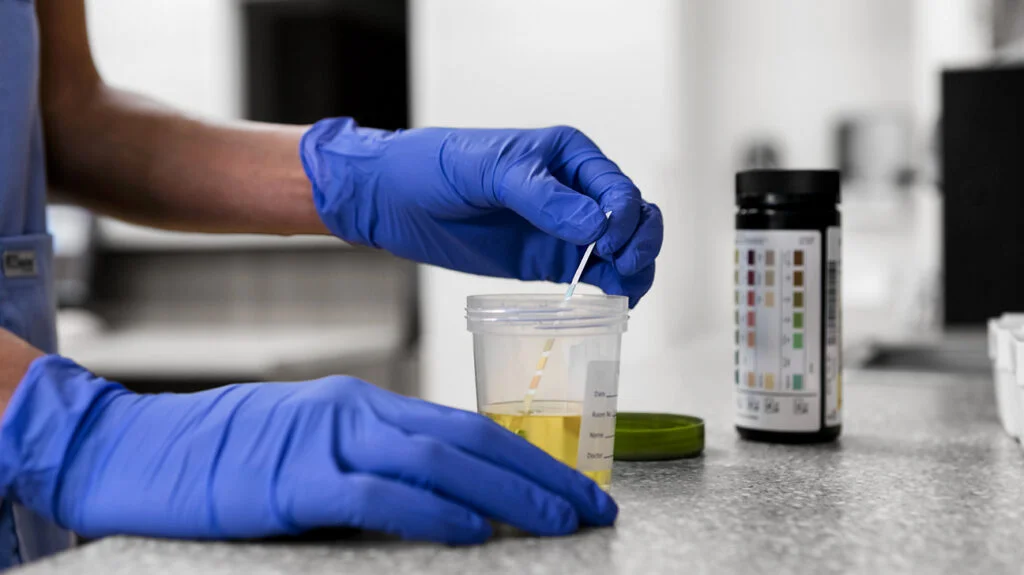So, how long does fentanyl stay in your urine?
Understanding how long fentanyl and its metabolites remain detectable in urine is vital for medical, forensic, and substance abuse contexts.
This article explores the detection timeframe of fentanyl and its metabolite in urine tests, providing essential insights for those seeking to understand the persistence of this potent opioid in the human body.
How Long Does Fentanyl Stay in Your Urine?
Generally, fentanyl can be detected in urine for 24 to 72 hours post-consumption, but this can vary based on individual factors and usage patterns.
Factors Affecting Fentanyl Detection in Urine
Individual Variability in Metabolism, Dosage, and Frequency
The detection of fentanyl in urine is highly individualized and varies significantly based on several factors.
Metabolism is a key component; individuals with a faster metabolic rate tend to process and eliminate substances like fentanyl more quickly.2
Conversely, those with slower metabolism might retain the drug longer, extending its detection window.
Dosage also plays a pivotal role – higher doses of fentanyl are not only more likely to be detectable for a longer duration but can also impact the body’s ability to metabolize the drug efficiently.
The frequency of usage is another crucial factor.
Occasional users may find that fentanyl is cleared from their system relatively swiftly, while regular or chronic users might experience an accumulation effect, where the drug remains detectable for an extended period.
This accumulation can be further influenced by factors such as the user’s overall health, kidney function, and even hydration levels, all of which affect how the body processes and excretes fentanyl.
What Affects Fentanyl’s Detection Time in Urine?
“Detection time can be influenced by several factors, including the individual’s metabolism, dosage, frequency of use, and the specific type of test used.”
Study Insights on Fentanyl Detection
Detection Timeframe Post-Consumption
Research conducted by Boston University sheds light on the detection timeframe of fentanyl in the body post-consumption.3
The study reveals that after taking one or a few doses of fentanyl, it is typically cleared from the body within 2 to 4 days.
This finding is crucial for understanding how long fentanyl, including its metabolites, stays in the urine, particularly for occasional users.
It highlights the relatively short window in which fentanyl can be detected, emphasizing the need for timely testing in medical and forensic scenarios.
Variability in Detection Windows
Further insights come from information provided by Drugs.com, which underscores the variability in the detection window for fentanyl.4
According to their data, drug testing can detect fentanyl or its metabolites in urine typically for 24 to 72 hours.
This range indicates that while some individuals may excrete fentanyl quickly, others may retain it for a longer duration.
This variability is influenced by several factors, including metabolism, body mass, hydration levels, and overall health, thereby affecting the reliability and interpretation of urine drug tests for fentanyl.
How Reliable are Urine Tests for Fentanyl?
“While urine tests are a common method for detecting fentanyl, their reliability can vary based on the test’s sensitivity and the timing of the test post-exposure.”
The Role of Fentanyl Analogues
Fentanyl analogues, closely related chemical variants of fentanyl, significantly contribute to the complexity of opioid overdose cases.
These analogs, like carfentanil and acetyl fentanyl, often vary in potency, sometimes being even more powerful than fentanyl itself.
A study highlighted by PubMed emphasizes the critical role these analogs play in overdose deaths.
The challenge with fentanyl analogs lies not only in their potent effects but also in their detection.
Many standard drug tests may not be sensitive enough to identify these variants, leading to underreporting and misdiagnosis in overdose incidents.
This makes understanding and detecting fentanyl analogs crucial in the efforts to combat the opioid epidemic.
How Do Fentanyl Analogues Differ from Fentanyl?
“Analogues may have different chemical structures leading to varying effects, potency, and detection challenges compared to fentanyl.”
Testing Methods and Accuracy
Exploring Testing Methods for Fentanyl Detection
Various testing methods are employed to detect fentanyl in urine, each with unique characteristics.
The most common is the immunoassay test, which is quick and cost-effective, making it suitable for initial screening.
However, for more precise results, particularly in legal or medical scenarios where accuracy is paramount, gas chromatography-mass spectrometry (GC-MS) or liquid chromatography-tandem mass spectrometry (LC-MS/MS) are used.
These methods are more sensitive and specific, capable of detecting not only fentanyl but also its various metabolites and analogues in urine samples.
Reliability and Limitations of Fentanyl Urine Tests
While these testing methods are advanced, they are not without limitations.
The reliability of immunoassay tests can be affected by factors such as the specific fentanyl analogue present and the sensitivity of the test.
False positives and negatives are possible, particularly with less specific tests.
The more sophisticated GC-MS and LC-MS/MS methods offer higher accuracy but are more costly and time-consuming, limiting their use to confirmatory testing.
Understanding these limitations is crucial for interpreting the results of fentanyl urine tests accurately, especially in contexts where precise detection is critical.
Implications for Health and Law Enforcement
Addressing Substance Abuse and Overdose with Detection Knowledge
Understanding the detection window of fentanyl in urine is pivotal in tackling substance abuse and managing overdose incidents.
This knowledge is instrumental for health professionals in providing timely and appropriate care to individuals who have consumed fentanyl, whether intentionally as part of a prescribed treatment or unknowingly through illicit use.
Accurate detection is crucial for making informed decisions about the course of treatment for overdoses, which often require immediate and specific interventions to counteract the effects of fentanyl.
Furthermore, this detection knowledge plays a vital role in assessing the risk of dependence or abuse in patients.
It enables healthcare providers to identify patterns of misuse, guiding them in offering targeted support and intervention strategies.
For public health initiatives, the ability to accurately identify the presence of fentanyl in the system is fundamental in designing effective strategies for opioid misuse prevention and education.
It aids in informing policy decisions, resource allocation for treatment programs, and the development of community outreach efforts aimed at reducing the incidence of fentanyl misuse and overdose.
The effective detection of fentanyl is crucial not only from a medical perspective but also in the broader effort to combat the opioid crisis.
The Role of Urine Tests in Legal and Medical Contexts
Urine tests for fentanyl hold significant importance in both legal and medical scenarios.
In medical settings, these tests are crucial for monitoring patients’ adherence to prescribed opioid treatments, ensuring they are receiving and using their medication as intended.
They also play a key role in identifying potential drug abuse, aiding healthcare professionals in developing appropriate intervention strategies for patients struggling with addiction.
In the legal sphere, urine tests for fentanyl are frequently employed within the criminal justice system.
They are a standard method for drug screening of individuals under probation or parole supervision, helping to enforce compliance with court-mandated drug-free policies.
In the workplace, these tests are integral to drug testing policies, ensuring employee safety and adherence to workplace standards.
The accuracy and reliability of urine tests in detecting fentanyl are paramount, as they have direct implications on legal outcomes and medical treatment plans.
The test’s ability to differentiate between prescribed use and illicit consumption is critical in avoiding false positives, which can have serious legal or employment consequences.
Moreover, in medical scenarios, precise detection helps in tailoring patient care, particularly in managing potential cases of overdose or in adjusting pain management strategies.
The effectiveness of these urine tests is not just a matter of technical accuracy, but also one of significant impact on individual lives and broader societal concerns.

Understanding Fentanyl
What is Fentanyl?
Fentanyl stands out as a synthetic opioid, widely recognized for its remarkable effectiveness in managing pain.
It is an exceptionally powerful medication, primarily utilized for treating severe and often debilitating pain, making it a common choice for post-surgical care or for patients grappling with chronic pain conditions, such as those associated with advanced cancer.
Fentanyl’s potency stems from its ability to interact with the brain’s opioid receptors at a much higher intensity compared to other pain relievers.1
This interaction not only significantly diminishes the sensation of pain but also induces feelings of relaxation and euphoria, which can be psychologically addictive.
Its formulation allows it to provide quick and substantial pain relief, but this also contributes to its high potential for abuse and dependency, particularly when used outside the bounds of medical supervision.
Fentanyl Potency and Medical Application
Fentanyl’s extraordinary potency, being approximately 50 to 100 times stronger than morphine, marks it as a uniquely powerful opioid in the medical arsenal.
This immense strength makes fentanyl particularly valuable in clinical settings, especially for managing severe or breakthrough pain in patients who have developed a tolerance to less potent opioids.
Its effectiveness in pain management is crucial for conditions like advanced cancer pain, severe back injuries, or post-operative care, where other pain relief options may prove insufficient.
In hospital environments, fentanyl is administered in various forms depending on the patient’s needs and medical situation.
It is often given via injections for quick and controlled pain relief, especially in post-operative settings or in emergency care.
Transdermal patches are used for continuous, long-term pain management, releasing fentanyl slowly into the bloodstream over time, ideal for chronic pain patients.
Additionally, lozenges and buccal tablets are utilized for managing breakthrough pain, offering a more manageable method of dosing for patients.
In all its forms, the administration of fentanyl requires meticulous dosing and vigilant monitoring due to its potency, ensuring effective pain relief while diligently minimizing the risks of overdose and dependency.
Illicit Use and Its Dangers
Fentanyl, while a potent medicinal tool, becomes perilously dangerous when diverted for illicit use.
Its extreme potency, being far greater than many other opioids, significantly heightens the risk of overdose and death.
This is particularly true in recreational use or when fentanyl is mixed with other substances like heroin or cocaine, often without the user’s knowledge.
Such combinations can lead to severe, sometimes fatal, consequences due to fentanyl’s unpredictable and powerful nature.
The illicit fentanyl market has been a key factor in the global surge of opioid-related overdose deaths.
The substance’s potency is so high that even minuscule amounts, comparable to a few grains of salt, can be lethal.
This risk is further exacerbated when fentanyl is illicitly manufactured, as variations in purity and composition can make its effects even more unpredictable and dangerous.
The synthetic nature of fentanyl allows for its manufacture in labs without the need for natural opium derivatives, making it a prevalent choice for illegal drug producers.
This accessibility has led to a widespread presence of fentanyl in the illegal drug market, with dire public health implications.
The challenge posed by illicit fentanyl extends beyond individual users to encompass broader public health and law enforcement efforts.
It’s a significant obstacle in the fight against the opioid crisis, necessitating increased vigilance, law enforcement efforts, and public education to raise awareness about the risks associated with its use.
The capacity of fentanyl to cause harm in such small quantities and its prevalent illicit use underscore the critical need for targeted strategies to address this growing concern.
Advancing the Battle Against Fentanyl
The detection window of fentanyl in urine, influenced by various factors, including individual metabolism, dosage, and frequency of use, is a critical aspect of medical diagnostics, law enforcement, and public health strategies.
Insights from recent studies have enhanced our understanding of how long fentanyl and its metabolites remain detectable, a key factor in addressing substance abuse and overdose cases.
As ongoing research sheds more light on fentanyl’s impact, it further informs and refines our approaches to dealing with this potent opioid, both in individual cases and within the broader community.
Article Highlights:
- Fentanyl can typically be detected in urine for 24 to 72 hours post-consumption, varying by individual factors like metabolism and usage.
- The detection time is influenced by metabolism, dosage, frequency of use, and the type of test used.
- Urine tests are a common method for fentanyl detection but vary in reliability based on the test’s sensitivity and timing.
- Fentanyl analogues, with different structures and effects, pose additional challenges for detection and contribute significantly to overdose rates.
Are You Struggling with Fentanyl Addiction?
Cornerstone Healing Center in Arizona stands out as a top-rated addiction rehab facility in Arizona, particularly for individuals struggling with fentanyl addiction.
Cornerstone emphasizes holistic healing by adopting a comprehensive approach that addresses not only the physical aspects of addiction but also the emotional and psychological facets, ensuring a well-balanced, long-lasting recovery.
Please reach out to us today to start your journey toward overcoming fentanyl addiction and regaining control of your life!
SOURCES
[1] Fentanyl
[3] Fentanyl and Norfentanyl Detected in Urine for 7 or More Days After Regular Use
[4] How long does Fentanyl stay in your system?






